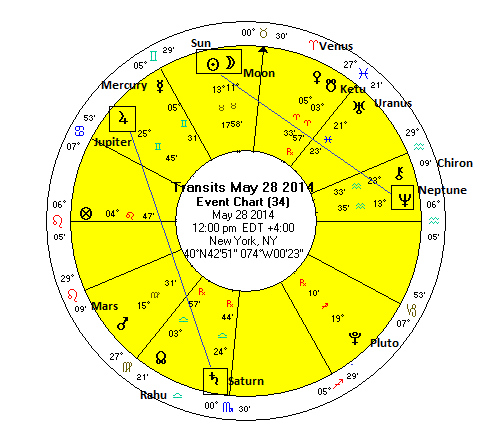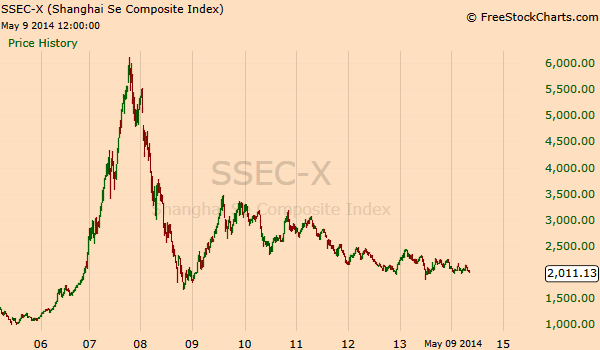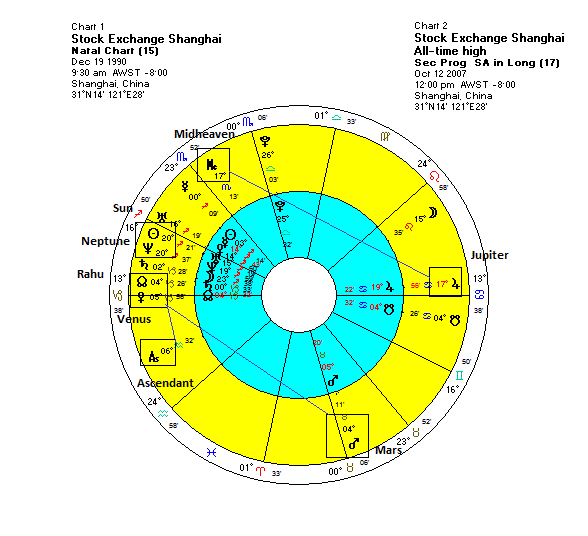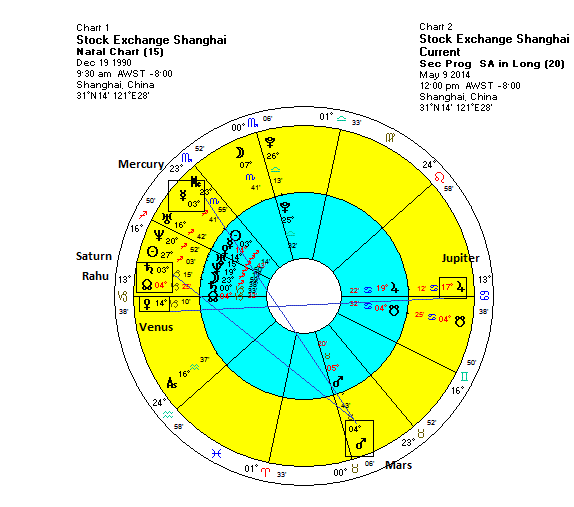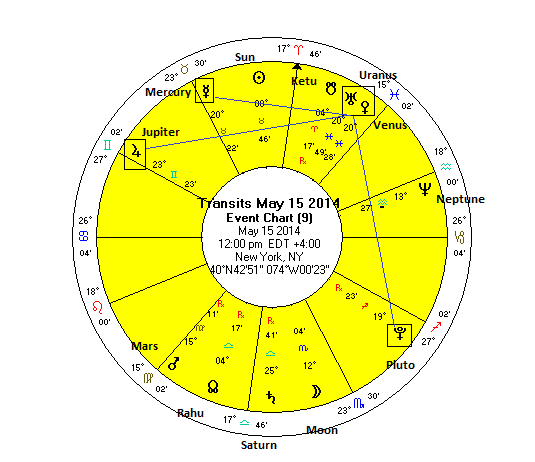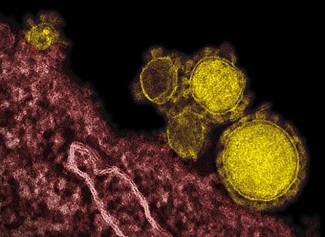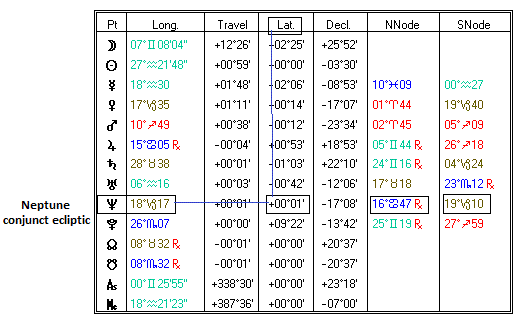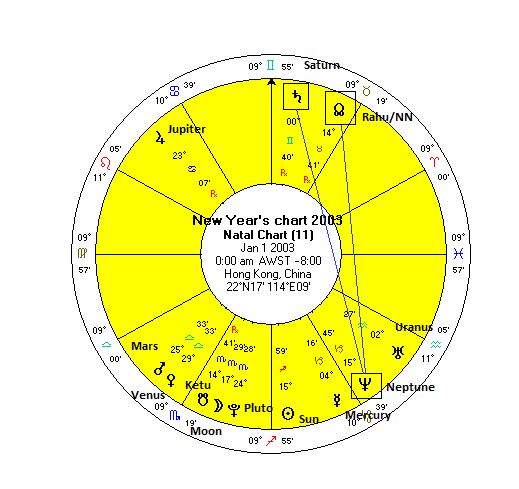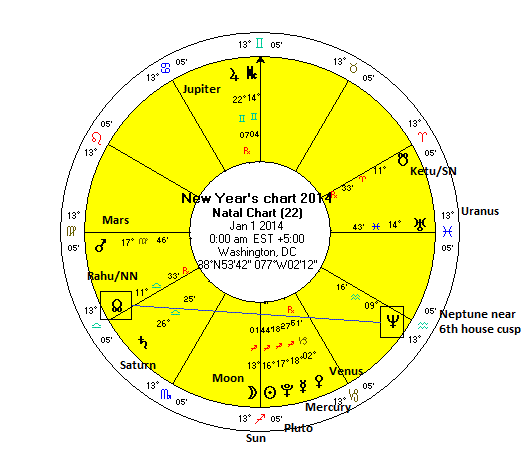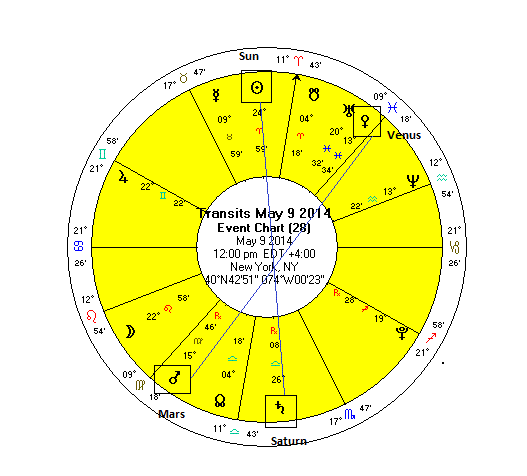 (25 May 2014)
Democracy in Thailand took a step backward last week as the military
launched its 12th successful coup since 1932, the year that marked the
end of the absolute monarchy in what was then Siam. The coup attempted
to restore order in Bangkok following a period of protests and violent
unrest against the elected government of Yingluck Shinawatra, the sister
(and proxy) of the exiled former PM Thaksin Shinawatra. The coup is
the latest move in an ongoing struggle between the populist Thaksin and
his mostly rural and working class supporters and the royalist elites
and their middle class supporters centered around the capital Bangkok.
Since first becoming PM in 2001, Thaksin and his surrogates have won the
largest majorities in the history of Thai democracy but have been
widely criticized for corruption, human rights violations and censorship
of the media. Under the leadership of General Prayuth Chan-Ocha, the
military junta is generally regarded as favoring the monarchy and
traditional elites and is hostile to Thaksin's new-style authoritarian
populism. The military's promise to reform the constitution before new
elections may be seen as a warning against the Thaksin regime.
(25 May 2014)
Democracy in Thailand took a step backward last week as the military
launched its 12th successful coup since 1932, the year that marked the
end of the absolute monarchy in what was then Siam. The coup attempted
to restore order in Bangkok following a period of protests and violent
unrest against the elected government of Yingluck Shinawatra, the sister
(and proxy) of the exiled former PM Thaksin Shinawatra. The coup is
the latest move in an ongoing struggle between the populist Thaksin and
his mostly rural and working class supporters and the royalist elites
and their middle class supporters centered around the capital Bangkok.
Since first becoming PM in 2001, Thaksin and his surrogates have won the
largest majorities in the history of Thai democracy but have been
widely criticized for corruption, human rights violations and censorship
of the media. Under the leadership of General Prayuth Chan-Ocha, the
military junta is generally regarded as favoring the monarchy and
traditional elites and is hostile to Thaksin's new-style authoritarian
populism. The military's promise to reform the constitution before new
elections may be seen as a warning against the Thaksin regime.In a previous article from early February, I had suggested that a coup was more likely to occur in June and July around the Saturn-Uranus alignment which activated a key planet in the 1932 chart of Thailand. This prediction was somewhat off the mark in terms of timing (the coup happened on May 22 -- just two days after Mars stationed direct), although we can see from the chart just how close that Saturn-Uranus alignment is to Mercury (21 Gemini). Mercury is doubly important in this chart because it is the chart ruler (Lagnesh) since Gemini rises.
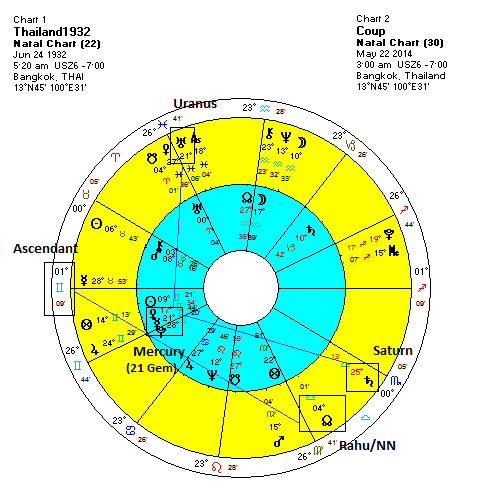
In addition, the disruptive effects of the Moon's nodes are very much in play with this coup as transiting Rahu (4 Libra) is closely aspecting the Ascendant at 1 Gemini through its 120 degree trine aspect. Rahu (North Node) is a natural malefic and is often prominent in situations where the status quo is upset. That is very much the case here as the Yingluck government had been in power since 2011 but over the past six months had lost its ability to govern as the protests persisted and the Supreme Court eventually ruled against it. My original prediction focused on the timing of the exact trine aspect of Rahu to the Ascendant in June and July. The three degree orb is still very much within allowable limits so we have to assume that Rahu definitely had a hand in the coup.
What's next for Thailand? There is already resistance to the coup in Bangkok as supporters of the Yingluck government and pro-democracy activists have staged small protests designed to test the military's resolve. Astrologically, I would think we could see this kind of ongoing popular opposition for some time to come. Late June in particular may be an important time as Mars (conflict) opposes Uranus (change) both align with that aforementioned Mercury. This appears to be a sharp rise in violence and harm although it is very unlikely to damage or unseat the junta. The added problem here is that the tense and conflictual Mars-Uranus opposition will be imprinted in the June 24th Solar Return chart of the 1932 horoscope. This is another reason why we should expect more unrest and violence throughout the next 12 months at least.
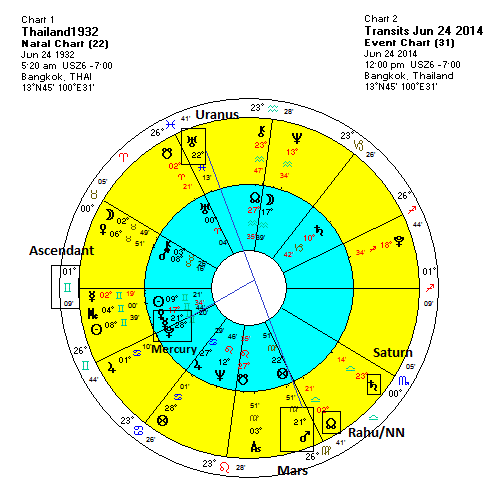
More immediately, I would expect Thailand to remain unstable and volatile well into July as Mars will conjoin Rahu at 0 degrees of Libra exactly opposite the natal Uranus. That looks like a sudden and shocking attack of violence. Unlike previous coups which saw a quick return to peace and civil order in Thailand, this one looks shakier as if protests and unrest will continue in spite of the show of force. As some Thai editorial writers have suggested, there is the real chance that the coup will actually make things worse rather than better.
The larger question is where all this leaves Thaksin Shinawatra. The exiled telecommunications billionaire has tried to rule Thailand in absentia through his sister Yingluck. Since he was deposed in a coup in 2006, the chess game between old and new elites has continued apace, with each side vying for advantage at every opportunity. The old royalist elites are in the driver's seat now as Thaksin must be content to sit back and plan his next move. He will have to wait for electoral reforms to be passed in the coming months (or years) and hope to recast his Pheu Thai party, assuming its principals have not been barred or imprisoned.
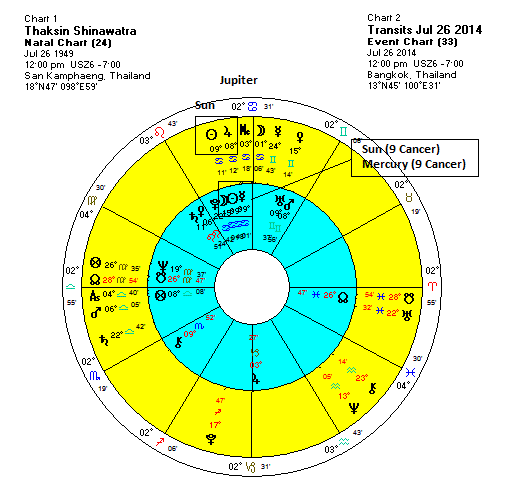
Thaksin's horoscope (July 26, 1949; no time) looks like a mixed bag for 2014. Late July and early August should be positive as Jupiter and Venus will conjoin his natal Sun-Mercury conjunction. This suggests advancement of his interests and a fulfillment of his wishes. But the end of 2014 looks more difficult as transiting Ketu conjoins his Rahu and then transiting Saturn squares his Venus-Saturn combination into early 2015. This looks quite intense and even pivotal in terms of his ultimate goal of returning to Thailand and again taking the reins of power. It does not seem positive so he could suffer another setback in that regard. This could manifest as a banning of his political party in any upcoming election or as a loss of a key ally among the establishment or royal elites. Thaksin's fortunes may well improve in the second half of 2015 and look much better if we look out into 2016 and 2017. The fugitive exiled former PM Thaksin Shinawatra may therefore have to be patient and wait for his next move at the political chess board.
Modi to be sworn-in on Monday the 26th
Meanwhile, India's incoming PM Narendra Modi will be sworn-in at 6 p.m. on Monday the 26th. I hope to post something in greater detail once we know the exact time of the oath-taking but for now I would say that the chart looks quite active and has a strong nodal presence. Both Rahu and Ketu are prominent in this chart given Ketu's conjunction with Venus and Mercury's aspect from Rahu. This is perhaps not too surprising since the nodes are seen as harbingers of change which is why Modi was elected. Deliberative and cautious Saturn will be rising in the Ascendant in Libra, its sign of exaltation, so this may well mark his administration as one given to thoughtful and methodical planning. The Jupiter aspects suggest that results will be good and economic growth should follow. However, the Moon is somewhat distressed by the aspect from Mars so that suggests an uncomfortable level of conflict and rancour. I will revisit some of these ideas after the swearing-in has been completed and we know the exact time.
Financial Markets Update
Stock markets generally rose last week as the Fed continued its soothing tones of near-perpetual low rates and economic recovery. In New York, the Dow climbed more than 100 points finishing at 16,606. Indian stocks did even better as the post-election rally delivered further gains on hope for substantive economic reforms. The Sensex rose more than 2% ending the week at 24,693. While I had been fairly non-committal last week, we did see some declines early in the week around the Mars direct station just as I had suggested. I had also forecast a greater likelihood of gains in the second half of the week which also largely came to pass.
This week could see some early week gains around the Venus-Mercury-Ketu alignment. Wednesday's Sun-Neptune square looks more difficult, however, especially in the US. It is hard to say if stocks can continue their winning ways here since Jupiter is now separating from its aspect with Saturn, the last Jupiter aspect in a series that began in February. This could diminish collective optimism and leave financial markets in a more vulnerable condition.
